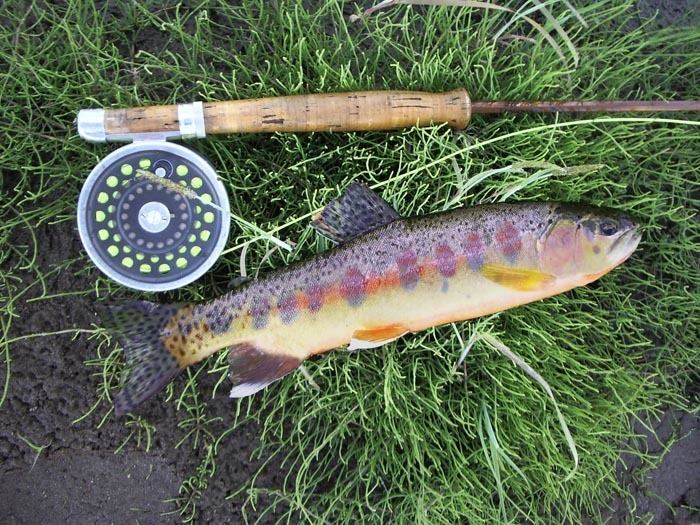Higher classification Oncorhynchus | Scientific name Oncorhynchus chrysogaster Rank Species | |
 | ||
Similar Gila trout, Apache trout, Oncorhynchus, Citharidae, Salmonids | ||
Large fish decoy by ras female mexican golden trout
The Mexican golden trout (Oncorhynchus chrysogaster) is a species of fish in the Salmonidae family. The species is endemic to high-elevation headwaters of the Fuerte River, Sinaloa River, and Culiacán River drainages in the Sierra Madre Occidental in Mexico.
Contents
- Large fish decoy by ras female mexican golden trout
- Taxonomy
- Description
- Distribution
- Habitat
- Status and threats
- Economic benefits
- References

Taxonomy

In 1936, Paul Needham, a fisheries biologist with the U.S. Bureau of Fisheries began a series of explorations (1936, 1937 and 1938) into the Rio Santo Domingo drainage in Baja California seeking to bring back live specimens of the Baja rainbow trout as hatchery stock and further study. Although live specimens reached U.S. hatcheries, none ever survived to spawn. In 1952, 1955 and 1956 Needham again explored the Sierra Madre Occidental tributaries of the Gulf of California. Needham's explorations led to the publication of Rainbow Trout of Mexico and California (1959) with coauthor Richard Gard. It contains the first full color drawing of the Mexican golden trout. In 1964, Needham and Gard's proposed binomial name Salmo chrysogaster was accepted as the scientific name for a new species of trout, the Mexican golden trout. The specific name chrysogaster is derived from the Greek for "golden belly". In 1989, morphological and genetic studies indicated trout of the Pacific basin were genetically closer to Pacific salmon (Oncorhynchus species) than to the Salmos–brown trout (S. trutta) or Atlantic salmon (S. salar) of the Atlantic basin. Thus, in 1989, taxonomic authorities moved the rainbow, cutthroat and other Pacific basin trout, including the Mexican golden trout into the genus Oncorhynchus.
Description

The Mexican golden trout is sexually dimorphic, males can easily be identified from females due to their much longer jaws or kype. Mexican golden trout are brightly colored with blue parr marks on both males and females along the side of the body. Purple scaling is visible along the lateral line. Both sexes also have bright golden-yellow belly coloration. The top of the fish and the tailfin are covered in small black spots with much larger spotting on the dorsal fin. The pectoral fins, pelvic fin and anal fin are light orange in color with white tips. Due to their harsh and small stream habitat the Mexican golden trout remains small even when fully grown. Adults rarely reach over a foot long with the maximum size probably being 10 inches (25 cm). Overall body shape and fin placement nearly identical to Rainbow trout Parr marks usually remain distinct throughout the fish's life.
Distribution

Mexican golden trout have an extremely limited range, being found only in the pristine high-elevation headwaters of the Fuerte River, Sinaloa River, and Culiacán River drainages in the Sierra Madre Occidental. This fish is highly restricted, and only known from 15 localities, one in the Sinaloa, four in the Culiacan, and ten in the Fuerte.
Habitat

Mexican golden trout are limited to small streams created by small cienegas (spring-fed marshes) above 5,000 feet. The surrounding landscape is dominated by deep canyons, scrub forest, evergreens and hardwoods.
Status and threats

Due to their small range and highly sensitive, isolated habitat, Mexican golden trout are considered vulnerable. The biggest threats are human development and the possibility of competition/interbreeding with introduced rainbow trout.
Economic benefits
The scenic area and rugged mountainous landscape have started a budding tourism industry for this area. Being able to conserve and promote the sustainable harvesting of these native trout can help the people of the area as well as the Golden Trout. Setting up regulations on the harvesting of the fish and restrictions on polluting the head waters these fish inhabit would greatly improve the region. In Arizona and New Mexico there was 512 million dollars that was spent on trips and equipment for fishing. This revenue could be a major contributor to helping the area grow and being able to conserve the local environment from destruction.
